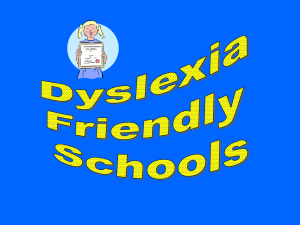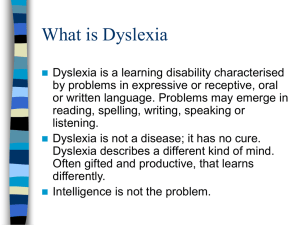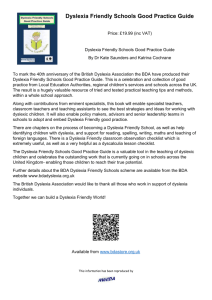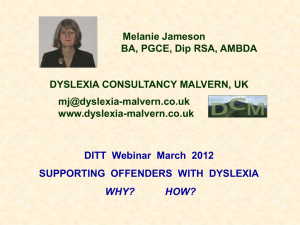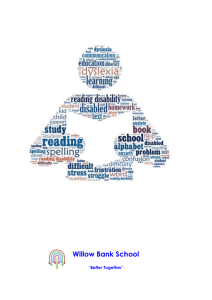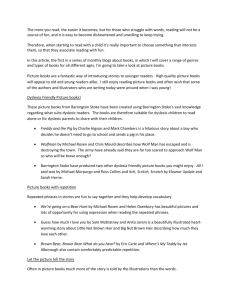Additional useful documents
advertisement
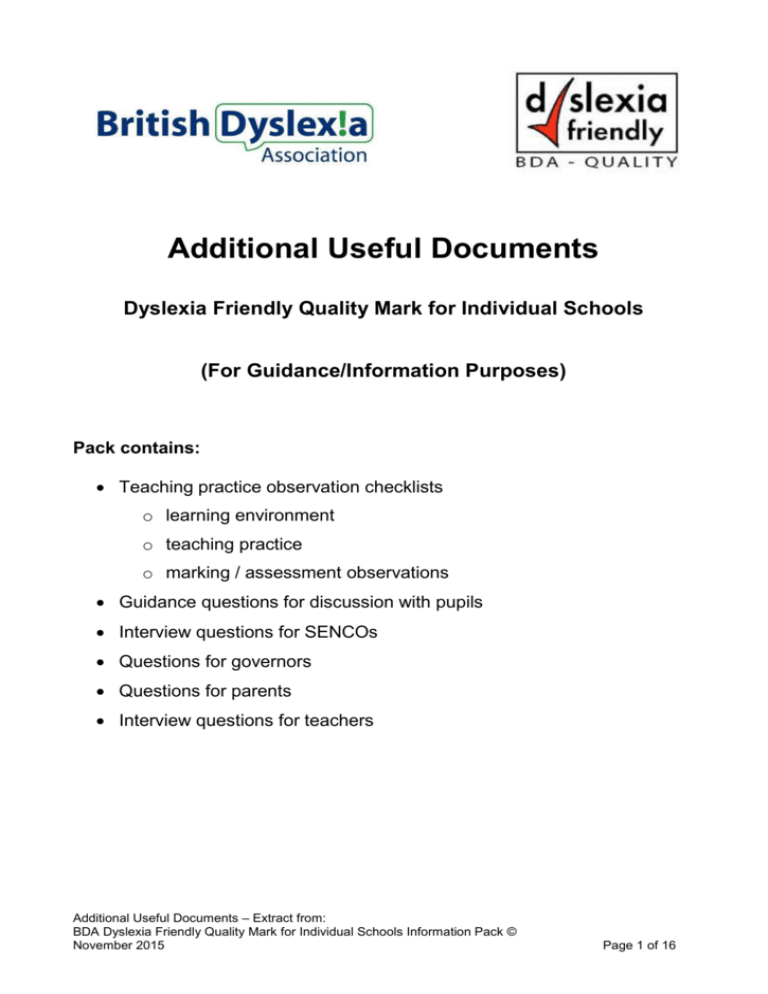
Additional Useful Documents Dyslexia Friendly Quality Mark for Individual Schools (For Guidance/Information Purposes) Pack contains: Teaching practice observation checklists o learning environment o teaching practice o marking / assessment observations Guidance questions for discussion with pupils Interview questions for SENCOs Questions for governors Questions for parents Interview questions for teachers Additional Useful Documents – Extract from: BDA Dyslexia Friendly Quality Mark for Individual Schools Information Pack © November 2015 Page 1 of 16 Teaching Practice Observation Checklist No. 1 Learning Environment Achieved Y\N Comments The room is well ventilated and at an appropriate temperature 2 The room is well lit ideally with natural light 3 Dyslexic pupils are placed near to the front of the class within easy view of the teacher 4 Dyslexic pupils are positioned so that they have a clear view of the board 5 Dyslexic pupils have sufficient space to accommodate their work, particularly left handers 6 The classroom is as quiet as possible to avoid noise disturbance 7 Movement around the classroom is minimized to avoid visual disturbances 8 Sources of equipment/resources are clearly labelled and organized 9 Key words/vocabulary are placed strategically around the classroom to support current topics 10 Desk top aides are available and their use encouraged Additional Useful Documents – Extract from: BDA Dyslexia Friendly Quality Mark for Individual Schools Information Pack © November 2015 Page 2 of 16 No. 1 Teaching Practice Achieved Y\N Comments Clear objectives are stated at the start of the lesson (the big picture is given) 2 Links to previous learning are made 3 Priority points and\or new\key vocabulary are given, explained and recorded clearly, such as through bullet points, wall displays, etc. 4 The teacher utilizes a multi-sensory approach for all learning points throughout the session, taking into account all learning styles 5 There is a minimum requirement for dyslexic pupils to record/copy information from the board or from books. 6 Teacher notes/handouts that contain the learning points are readily available for pupils 7 Pupils are encouraged to record information in a variety of ways, e.g. mind maps, diagrams, bullet points, pictures, etc. 8 All pupils are actively encouraged to make verbal contributions and take part in discussions 9 Dyslexic pupils are not made to read or write in front of the class Additional Useful Documents – Extract from: BDA Dyslexia Friendly Quality Mark for Individual Schools Information Pack © November 2015 Page 3 of 16 Observation of Teaching Practice continued... No. 10 Teaching Practice Achieved Y\N Comments Resources/handouts are tailored to meet the needs of dyslexic pupils 11 Collaborative working is encouraged including, group work, the sharing of notes, learning buddies, etc. 12 The pace of the session should take into account the needs of learners with time built in for thinking time/brain breaks 13 Frequent and effective use is made of questioning both open & closed questions to check understanding 14 Pupils are not expected to multi-task and tasks are clearly demarcated as looking, listening and writing with an equal balance of such tasks being evident 15 The lesson follows a logical sequence with each learning point leading on from the previous. Links between these learning points are frequently reinforced and made explicit 16 Pupils are encouraged to ask questions and make oral contributions 17 Additional time is allowed within sessions for dyslexic pupils to process information and for reading and writing 18 Key points are reinforced and highlighted Additional Useful Documents – Extract from: BDA Dyslexia Friendly Quality Mark for Individual Schools Information Pack © November 2015 Page 4 of 16 both orally and visually Additional Useful Documents – Extract from: BDA Dyslexia Friendly Quality Mark for Individual Schools Information Pack © November 2015 Page 5 of 16 Observation of Teaching Practice continued... No. 19 Teaching Practice Achieved Y\N Comments Effective use is made of colour, visual aids, etc within presented information to highlight key points 20 Instructions and information are broken down into small steps with no more than 3 clear pieces of information being given at one time. Checks of understanding are made after each stage 21 Handouts conform to dyslexia friendly guidelines 22 Positive and constructive feedback is given to pupils at appropriate intervals 23 Homework tasks are clearly explained and homework instructions are written down for dyslexic pupils. (Home work is not set in that last few minutes of the session) 24 Marking criteria are clearly explained to pupils 25 There is a recap of the objectives and key learning points at the end of the session Additional Useful Documents – Extract from: BDA Dyslexia Friendly Quality Mark for Individual Schools Information Pack © November 2015 Page 6 of 16 No. 1 Marking/Assessment Achieved Y/N Comments Homework set is appropriate for the individual pupil, where necessary it is differentiated 2 Pupils are encouraged to record homework in a variety of ways, if appropriate 3 Where appropriate homework is marked for content rather than accuracy of spelling, etc. Recognition is also given for effort 4 Feedback should be positive and constructive 5 A clear indication of the time to be spent on homework should be given 6 Clear and realistic deadlines for the submission of homework should be set, communicated and confirmed with the pupil and clearly recorded for them 7 Parents and pupils are encouraged to comment on the homework set and such comments are reviewed and utilised to inform future practice 8 Pupils know how to access additional support with homework if required 9 Reminders, such as notebooks, personal checklists, etc. are used to help pupils remember specific items/equipment for Additional Useful Documents – Extract from: BDA Dyslexia Friendly Quality Mark for Individual Schools Information Pack © November 2015 Page 7 of 16 future sessions Additional Useful Documents – Extract from: BDA Dyslexia Friendly Quality Mark for Individual Schools Information Pack © November 2015 Page 8 of 16 Guidance Questions for Discussions with Pupils 1. Do you like school? 2. What are the things that you like about school? 3. What are the things that you most dislike about school? 4. What are you good at? 5. What does it mean to you to be dyslexic? 6. How do your teachers help you? 7. Does anyone else help you in school? 8. If you need extra help do you know who to ask for it? 9. What would you like to do in the future? 10. Do your friends understand about dyslexia? 11. What could the school or your teachers do to help you more? 12. Do you have any problems completing homework? 13. If there was one thing that you could change about school what would it be? Additional Useful Documents – Extract from: BDA Dyslexia Friendly Quality Mark for Individual Schools Information Pack © November 2015 Page 9 of 16 Interview Questions for SENCOs 1. How many children are dyslexic in the school? 2. How many dyslexic children are at school action, school action plus and have statements? 3. Explain to me the process that you would implement if a child is giving cause for concern? How/who would initially identify concerns? 4. What screening/assessment tools do you use? 5. What qualifications do you have? (If not a specialist how do you access specialist support?) 6. What further CPD do you intend to take in the future to assist you in your role? 7. What specific intervention programmes do you have for dyslexic children? Who administers\supervises these? 8. How are the “softer” outcomes developed with dyslexic children, e.g. confidence, selfesteem, organisational skills, etc? 9. What additional resources are available to children & teachers in class to support the dyslexic children? 10. How do you communicate with parents and involve them in the support process? Additional Useful Documents – Extract from: BDA Dyslexia Friendly Quality Mark for Individual Schools Information Pack © November 2015 Page 10 of 16 11. How do you access additional advice and guidance if you need it? 12. What role does the LEA/CS play in the support process? 13. How do you support classroom teachers and TAs? 14. How do you make sure that individual class teachers and supply teachers are aware of the needs of the dyslexic children in their class? 15. What is the process for applying for exam concessions within the school? 16. How many children in the school have SEBD issues have these also been assessed for SpLD? 17. Do you feel that the resources that you currently have are adequate? What would you like to have and why? 18. How you feel that the Dyslexia Friendly Schools scheme has made a difference to: You Other member of staff The children Additional Useful Documents – Extract from: BDA Dyslexia Friendly Quality Mark for Individual Schools Information Pack © November 2015 Page 11 of 16 Questionnaire for Governors 1. Do school policies specifically refer to dyslexia? 2. Is a culture of valuing differences encouraged within the school, can you give an example of this? 3. Are special needs and inclusion seen as priority areas and specific targets set for these areas, what are these targets and how do governors monitor the achievement of these? What action would be taken if these targets were not being met? 4. What resources are allocated for special needs? 5. Do parents know where to go for help if problems are not resolved, what is the process for this and how frequently do parents make use of it? How are parents made aware of this process? 6. Have governors been given the opportunity to participate in dyslexia training, what did it involve? Additional Useful Documents – Extract from: BDA Dyslexia Friendly Quality Mark for Individual Schools Information Pack © November 2015 Page 12 of 16 Questionnaire for Parents 1. How do you feel your child is progressing in school? 2. Do you have any particular areas of concern? 3. Do you know who to contact to discuss any concerns? 4. What has been the response of the school to your concerns? 5. What kind of support does your child receive? 6. Do you feel that the level of support is appropriate to meet your child’s needs? 7. Is your child happy with their experiences at school? 8. Do you feel that the amount and/or type of homework set is appropriate for your child? 9. Has your child received support in developing study skills? 10. Has the school offered you any training/information about dyslexia? 11. Are there any other comments that you would like to add? Additional Useful Documents – Extract from: BDA Dyslexia Friendly Quality Mark for Individual Schools Information Pack © November 2015 Page 13 of 16 Interview Questions for Teachers 1. What process would you implement if a child is giving you cause for concern? What would you be looking for in terms of warning signs or indicators? 2. How many dyslexic children do you have in your class? 3. Explain to me that nature of the difficulties of two of these children? 4. What reasonable adjustments do you make for these children? 5. How do you implement the principles of a multi-sensory approach within your teaching 6. How do you ensure that the learning environment is dyslexia friendly? 7. How do you differentiate the curriculum for the dyslexic children within your class? How do you take into account intellectual ability as well as the dyslexia? 8. What is the school’s marking policy? How is this applied to dyslexic children? Additional Useful Documents – Extract from: BDA Dyslexia Friendly Quality Mark for Individual Schools Information Pack © November 2015 Page 14 of 16 9. How do you develop the softer outcomes such as self-esteem, organisational skills, etc. with these children? 10. What resources do you have available to you in the classroom to support the dyslexic children? 11. What training have you received in relation to dyslexia? What further CPD do you intend to take in this area? 12. How do you communicate with parents of dyslexic children? 13. Where/who do you go to if you require additional advice and/or support? 14. What role does the LEA/CS play in the support process? 15. How do you support TAs when they are working with dyslexic children? Additional Useful Documents – Extract from: BDA Dyslexia Friendly Quality Mark for Individual Schools Information Pack © November 2015 Page 15 of 16 16. Do you feel that the resources that you currently have are adequate? What would you like to have and why? 17. How you feel that the Dyslexia Friendly Schools scheme has made a difference to: You Other members of staff The children Additional Useful Documents – Extract from: BDA Dyslexia Friendly Quality Mark for Individual Schools Information Pack © November 2015 Page 16 of 16

